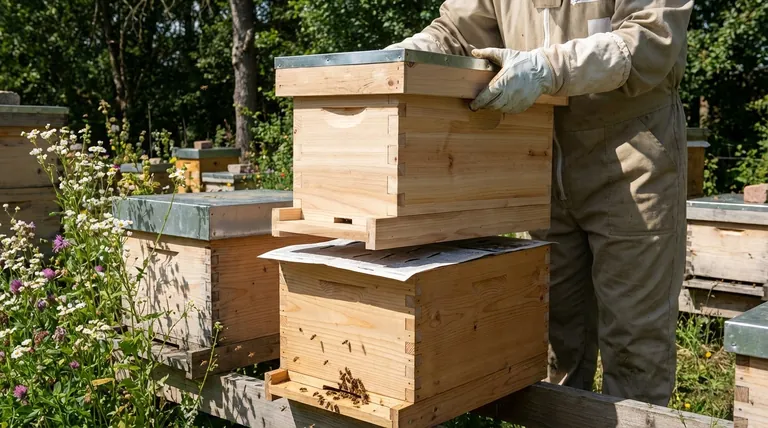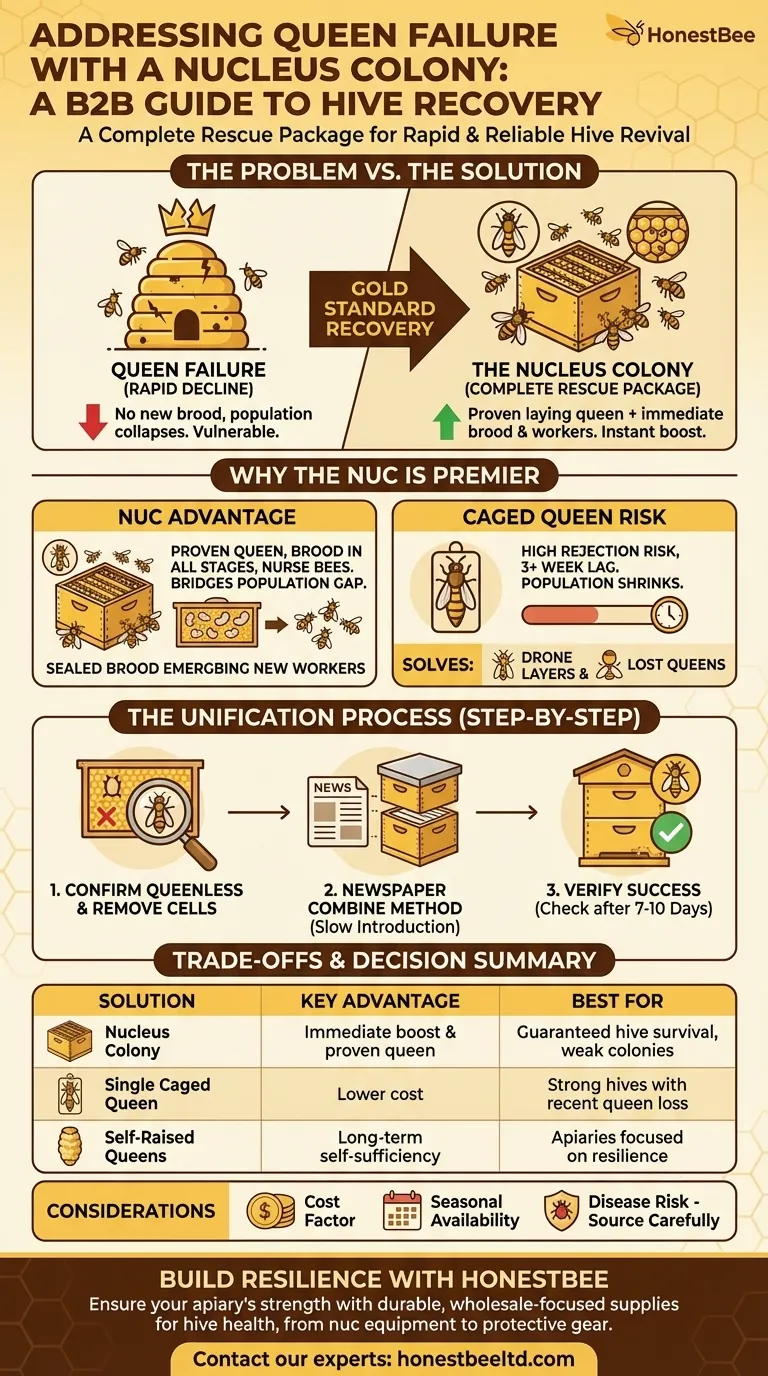Using a nucleus colony with a laying queen is one of the most effective methods for saving a hive that has lost its queen. Instead of just introducing a new queen, you are merging a small, fully functional colony into the queenless one, providing not only a proven queen but also a fresh supply of brood and worker bees to ensure a rapid recovery.
Queen failure is a critical event that can lead to a colony's rapid decline and collapse. Using a nucleus colony is the gold standard for recovery because it addresses the two core problems simultaneously: it replaces the queen and immediately reverses the colony's population decline.

Why a Nucleus is the Premier Solution
When a hive becomes queenless, it faces a cascading failure. The population of worker bees begins to dwindle with no new brood to replace them. A nucleus, or "nuc," is a complete rescue package that directly counters this.
Beyond Just a Queen: The Nuc Advantage
A nucleus isn't just a queen; it's a small, established colony. It typically contains a proven, laying queen, frames of brood in all stages (eggs, larvae, and pupae), and thousands of nurse bees to care for them.
This stands in stark contrast to introducing a single caged queen, which carries a significant risk of rejection by the hive.
The Problem with Simple Requeening
Introducing a lone queen is a gamble. The colony might not accept her, and even if they do, there is a considerable time lag. It can take over three weeks from the time she starts laying until her first offspring emerge as adult worker bees.
During this period, the hive's population continues to shrink, making it more vulnerable to pests and robbing.
Addressing the Time-Lag Crisis
A failing hive is in a race against time. A nucleus colony provides an immediate infusion of sealed brood that will soon emerge as new workers, bridging the population gap.
This boost is critical for maintaining the colony's strength and defending its resources while the new queen establishes her own brood pattern. This makes the hive's recovery faster and far more certain.
Solving Common Queen Disasters
A nucleus is the definitive answer to several queen-related emergencies:
- Drone Layer: If a queen fails to mate properly and only lays unfertilized drone eggs, the colony is doomed. A nuc replaces her and provides a fresh generation of worker bees.
- Supersedure or Lost Queen: If a queen is old, poorly performing, or accidentally killed, the hive may fail to raise a suitable replacement. A nuc provides a guaranteed, high-quality replacement and reinforces the weakened workforce.
The Unification Process: Step-by-Step
Combining a nucleus with a queenless hive is a straightforward process, but it requires care to ensure the two groups of bees accept each other.
Step 1: Confirm the Hive is Truly Queenless
Before you begin, you must be absolutely certain the failing hive has no queen. A hive will not accept a new laying queen if it already has one, even a failing one.
Thoroughly inspect the frames for the old queen. Also, destroy any emergency queen cells the workers may have started building, as their presence can interfere with acceptance.
Step 2: The Newspaper Combine Method
This is the safest and most widely used technique for merging two colonies. Place a single sheet of newspaper with a few small slits cut into it on top of the queenless hive's uppermost box.
Then, place the nucleus colony's box directly on top of the newspaper. The bees on both sides will slowly chew through the paper, allowing their scents to mingle gradually. This slow introduction prevents fighting and dramatically increases the odds of acceptance.
Step 3: Verifying Success
Leave the combined hive undisturbed for about a week. After 7-10 days, you can perform a quick inspection.
You should find that the bees have chewed through the newspaper and integrated into a single colony. Look for the new queen and confirm she is laying eggs. At this point, you can consolidate the frames into a single hive body.
Understanding the Trade-offs
While using a nucleus is a powerful strategy, it's important to be aware of the associated considerations.
The Cost Factor
A nucleus colony is significantly more expensive than buying a single caged queen. You are purchasing not just the queen but also the bees, brood, and drawn comb. This cost reflects the much higher probability of success and the resources you are gaining.
Availability and Timing
Nucs are typically produced and sold in the spring and early summer. If your queen fails later in the season, finding a nuc for sale can be difficult or impossible. This makes them an excellent tool for spring and summer management but less reliable for late-season emergencies.
Risk of Disease Transmission
Whenever you introduce bees from another apiary, you run a small risk of introducing pests like Varroa mites or diseases. It is essential to source your nucleus colonies from a reputable, trusted beekeeper who actively manages for hive health.
Making the Right Choice for Your Apiary
Your decision to use a nucleus colony versus another method depends on your specific goal and the condition of the hive.
- If your primary focus is the survival of a weak or dwindling hive: Use a nucleus. The immediate boost in population and the high success rate of queen acceptance are worth the investment.
- If your primary focus is cost-efficiency for a very strong hive: For a populous hive that just recently became queenless, introducing a single caged queen can be a viable, cheaper option if you can afford the 3-week time lag.
- If your primary focus is long-term self-sufficiency: The best strategy is to learn to raise your own queens and create your own nucleus colonies from your strongest hives, giving you complete control over your apiary's resilience.
By understanding the nucleus as a complete colony rescue package, you can move from simply reacting to queen failure to proactively ensuring your apiary's health and survival.
Summary Table:
| Solution | Key Advantage | Best For |
|---|---|---|
| Nucleus Colony | Immediate population boost & proven queen | Guaranteed hive survival, weak colonies |
| Single Caged Queen | Lower cost | Strong hives with a recent queen loss |
| Self-Raised Queens | Long-term self-sufficiency | Apiaries focused on resilience and control |
Ensure your apiary's survival and strength with the right equipment.
Queen failure can devastate a colony, but a rapid, effective response is key. HONESTBEE supplies commercial apiaries and beekeeping equipment distributors with the durable, wholesale-focused supplies needed to manage hive health, from nucleus colony equipment to protective gear.
Let us help you build a more resilient operation. Contact our wholesale experts today to discuss your apiary's specific needs and our full product catalog.
Visual Guide

Related Products
- 5 Frame Wooden Nuc Box for Beekeeping
- HONESTBEE Professional Long Handled Hive Tool with Precision Cutting Blade
- HONESTBEE Advanced Ergonomic Stainless Steel Hive Tool for Beekeeping
- HONESTBEE Professional Entrance Bee Feeder Hive Nutrition Solution
- Professional Insulated Plastic Bee Hives
People Also Ask
- What is the advantage of overwintering a nucleus? A Strategic Asset for Beekeeping Success
- What is a common feature of many 5-frame nuc boxes? The Integrated Feeder for Efficient Colony Growth
- What is the most common type of standard nuc? The 5-Frame Nuc Explained
- What is the purpose of having a nuc in beekeeping? Build a Resilient & Productive Apiary
- How many frames does a typical wooden nuc box hold? A Guide to Choosing the Right Size



















